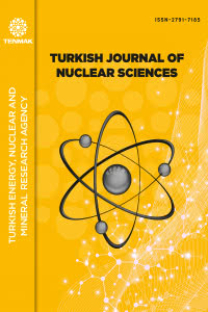AN INTERNATIONAL COMPARISON STUDY ON OSL DATING
To compare our experiment results with other laboratories by participating in international inter-laboratory comparison tests is an important need to ensure the accuracy of our measurements. However, so far, international comparison tests or measurements on OSL dating are unfortunately organized very limited in number. The latest inter-laboratory comparison study was conducted between 2006 and 2012 years by the Nordic Luminescence Laboratory in Denmark. In this paper, within the scope of the aforementioned comparison study, the result of Optical Stimulated Luminescence (OSL) dating of inter- comparison sample based on quartz-rich aeolian and/or coastal marine sand sample was presented. Equivalent dose (De) of the sample was determined using Single Aliquot Regenerative Dose (SAR) protocol. For the calculation of annual dose rate (Da), concentrations of radioactive isotopes (U, Th, K) were measured by using a high-purity germanium detector. OSL age was determined as 4530 ± 41 years for the sample. Consequently, within the error limits, we have determined the age of the sample close to the expected age. By participating in this comparison test, we have had the opportunity to compare our results with other luminescence dating laboratories and to ensure the accuracy of our results. At the same time, we had the chance to interpret each step of our dating measurements (preparation of pure quartz minerals, determination of equivalent dose and annual dose etc.) on an international scale, separately.
Keywords:
OSL dating, interlaboratory comparison, equivalent dose, quartz sar,
___
- Aitken, M.J. (1985). Thermoluminescence Dating. Academic Press, London. https://doi.org/10.1016/0033-5894(86)90112-2
- Aitken, M.J. (1998). An Introduction to Optical Dating. Oxford University Press, Oxford.
- Bøtter-Jensen, L., McKeever, S.W.S. and Wintle, A.G. (2003). Optically stimulated luminescence dosimetry. Elsevier Science B.V., 355 p., Netherlands.
- Guerin, G., Jain, M., Thomsen, K. J., Murray, A. S., Mercier N. (2015). Modelling dose rate to single grains of quartz in well-sorted sand samples: The dispersion arising from the presence of potassium feldspars and implications for single grain OSL dating. Quaternary Geochronology, 27, 52-65.
- G. Guérin, N. Mercier, G. Adamiec. (2011). Dose-rate conversion factors: update. Ancient TL. 29, pp. 5-8.
- Huntley, D.J., Godfrey-Smith, D.I., Thewalt, M.L.W. (1985). Optically dating of sediments. Nature, 313, 105-107
- Huntley, D.J., Hutton, J.T. and Prescott, J.R. (1993). Optical dating using inclusions within quartz grains. Geology, 21 (12), 1087-1090. https://doi.org/10.1130/0091-7613(1993)021<1087:ODUIWQ>2.3.CO;2
- Huntley, D. J. and M. Lamothe. (2001). Ubiquity of anomalous fading in K-feldspars and the measurement and correction for it in optical dating. Canadian Journal of Earth Sciences. 38(7): 1093-1106. https://doi.org/10.1139/e01-013 Madsen A.T., Murray A.S., Andersen T.J. (2007). Optical dating of Dune Ridges on Romo, A Barrier Island in Wadden Sea, Denmark. Journal of Coastal Research. 23 (5) 1259-1269. DOI: 10.2112/05-0471.1
- Madsen A.T and Murray A.S. (2008). Optically stimulated luminescence dating of young sediments: A review Geomorphology. 109, 23-16. https://doi.org/10.1016/j.geomorph.2008.08.020
- Murray, A.S., Wintle, A.G. (2000). Luminescence dating of quartz using an improved single-aliquot regenerative-dose protocol. Radiation Measurements. 32, 57. https://doi.org/10.1016/S1350-4487(99)00253-X
- Murray, A.S., Funder, S. (2003). Optically Stimulated Luminescence dating of a Danish Eemian coastal marine deposit: a test of accuracy. Quaternary Science Reviews 22, 1177-1183. doi: 10.1016/S0277-3791(03)00048-9
- Mejdahl, V. (1979). Thermoluminescence Dating: dose attenuation in quartz grains. Archaometry. 21, 61-72. https://doi.org/10.1111/j.1475-4754.1979.tb00241.xMurray, A.S., Buylaert, J., Thiel C. (2015). A luminescence dating intercomparison based on a Danish beach-ridge sand. Radiation Measurements. 81, 32-38 https://doi.org/10.1016/j.radmeas.2015.02.012
- Prescott, J.R., Hutton, J.T. (1994). Cosmic ray contributions to dose-rates for luminescence and ESR dating: large depths and long-term time variations. Radiation Measurements. 23(2/3), 497-500. https://doi.org/10.1016/1350-4487(94)90086-8
- McKeever S.W.S. (2001). Optically stimulated luminescence dosimetry Nucl. Instrum. Methods Phys. Res. B, 184 (1–2), pp. 29-54 https://doi.org/10.1016/S0168-583X(01)00588-2
- Vandenberghe, D. 2004. Investıgatıon of the optically stimulated luminescence dating method for application to young geologıcal sediments. Phd. Thesis. Universiteit Gent, 298s. Holland. Wintle, A.G., Murray, A.S., 2006. A review of quartz optically stimulated luminescence characteristics and their relevance in single-aliquot regeneration dating protocols. Radiat. Meas., 41, 369. https://doi.org/10.1016/j.radmeas.2005.11.001
- Başlangıç: 1981
- Yayıncı: -
